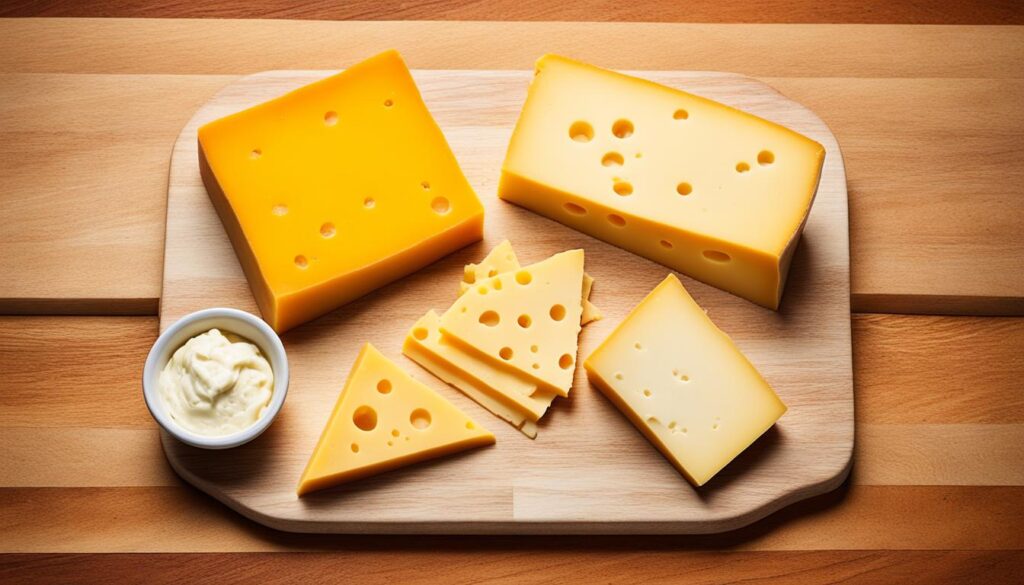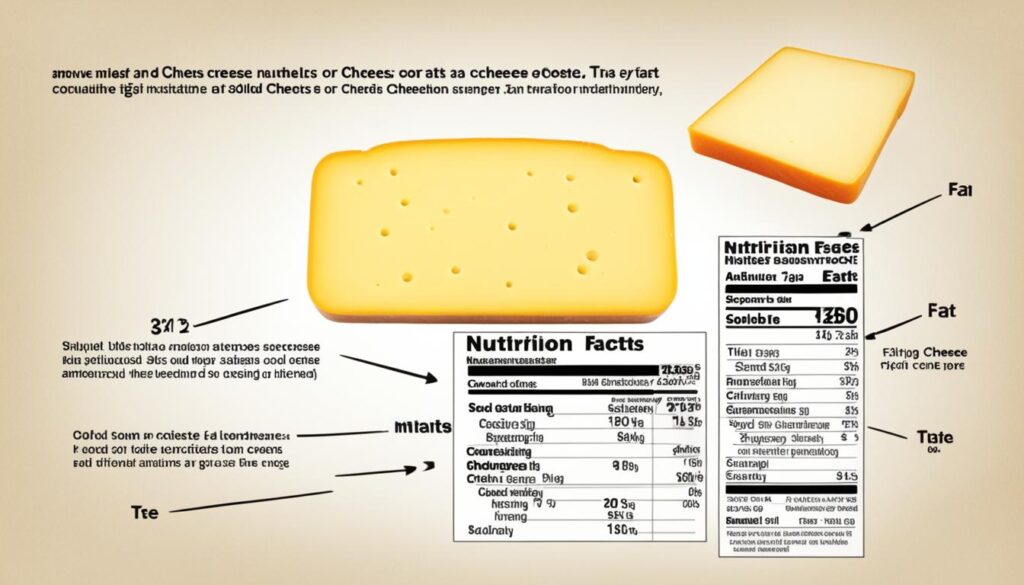Welcome to our article on the truth behind American cheese, where we take a closer look at what goes into this beloved classic. Many people wonder about the ingredients and composition of American cheese, and we’re here to provide the answers. So, let’s dive right in and uncover the secrets of American cheese.
American cheese, although widely enjoyed in the United States, is not considered “real” cheese by the FDA. Instead, it falls into the category of “processed cheese” or “cheese product.” This means that while it contains cheddar and colby cheeses, it also includes additional ingredients. These can include whey, milk proteins, vitamins, coloring, and emulsifying agents. Only slices that contain more than 51 percent real cheese can be legally labeled as American cheese. Those with less than 51 percent must be labeled as “process cheese food.”
The manufacturing process of American cheese involves melting grated cheese and then adding dairy products and flavorings. The mixture is then solidified into sliceable bricks or sheets. It’s important to read labels carefully to distinguish between genuine American cheese and impostors on the market.
In the next sections, we will delve deeper into the differences between white and yellow American cheese, explore how American cheese compares to cheddar cheese, examine its nutritional facts, and provide tips on identifying real cheese versus processed cheese. By the end of this article, you’ll be armed with the knowledge to make informed choices about the cheese you consume.
The Difference Between White and Yellow American Cheese
When it comes to American cheese, one may notice a distinct difference in color between white and yellow varieties. This variation in color is not merely for aesthetic purposes, but it actually serves as an indicator of the cheese’s composition and flavor.
White American cheese is left uncolored, maintaining its natural creamy hue. This variety is often favored for its mild and smooth taste, making it a versatile choice for various dishes.
Yellow American cheese, on the other hand, derives its vibrant color from the addition of natural colorings such as annatto or paprika. These natural colorants lend the cheese a cheddar-like appearance, making it visually appealing and reminiscent of the iconic yellow cheese. However, it is worth noting that cheaper brands might opt for artificial food dyes, so it is essential to check the label for transparency.
Composition and Taste
Despite their contrasting colors, both white and yellow American cheeses share the same composition and taste. These cheeses are typically made from a blend of cheddar and colby cheeses, combined with additional ingredients such as whey, milk proteins, vitamins, coloring, and emulsifying agents. The blending process ensures a consistent texture and flavor profile, making American cheese a popular choice for melting on burgers or grilling into flavorful sandwiches.
Ultimately, whether you prefer the pristine white or the vibrant yellow American cheese, rest assured that both varieties offer the same creamy goodness and versatility in your culinary endeavors.
| Characteristics | White American Cheese | Yellow American Cheese |
|---|---|---|
| Color | White | Yellow |
| Composition | Mixture of cheddar and colby cheeses blended with additional ingredients | Mixture of cheddar and colby cheeses blended with additional ingredients |
| Taste | Mild and smooth | Mild and smooth |
American Cheese vs. Cheddar: How Are They Different?
American cheese and cheddar cheese may appear similar, but they have distinct characteristics. Let’s explore the difference between these two popular cheese varieties.
Cheddar Cheese Composition
Cheddar cheese is made from 100 percent cow’s milk and is coagulated with rennet to separate curds and whey. The ingredients of cheddar cheese are limited to milk, salt, and food coloring. With its simple composition, cheddar cheese offers a pure and authentic taste.
American Cheese Melting Properties
On the other hand, American cheese is known for its exceptional melting properties. It contains added ingredients, including emulsifiers, which give it a smooth and creamy texture when melted. This makes American cheese a popular choice for melting on burgers and in grilled cheese sandwiches, as it creates that perfect gooey and stretchy consistency.
“American cheese’s emulsifiers lend it its fantastic meltability, making it a versatile option for all your melty cheese needs.”
Prepackaged Cheddar Slices
It’s important to note that prepackaged cheddar slices may contain authentic cheddar or “cheddar-flavored cheese products.” The latter is a blend of processed cheese slices mixed with flavorings to mimic the sharpness and tanginess of cheddar. These cheddar-flavored cheese products deliver a similar taste profile but may not offer the exact characteristics of traditional cheddar cheese.
To summarize:
| American Cheese | Cheddar Cheese |
|---|---|
| Contains emulsifiers for better melting properties | No emulsifiers; not ideal for melting |
| Smooth and creamy texture when melted | Hard and crumbly texture |
| Blend of cheddar and colby cheeses | Pure cow’s milk composition |

As you can see, American cheese and cheddar cheese have their own unique qualities and applications. Whether you prefer the meltability of American cheese or the traditional taste of cheddar, both options offer delicious additions to your favorite meals.
Nutritional Facts About American Cheese
While American cheese does offer some nutritional benefits, it is important to be mindful of its calorie and fat content. One slice of American cheese typically contains 9 grams of fat, with 5 grams being saturated fat, which is about 25 percent of the FDA’s recommended daily allowance.
On the positive side, American cheese is a good source of high-quality protein and is naturally rich in vitamins and minerals like vitamin D, vitamin A, calcium, phosphorous, and zinc.
Like all cheeses, American cheese should be enjoyed in moderation as part of a balanced diet.

Authenticity Check: How to Differentiate Real Cheese from Processed Cheese
To determine if your cheese is real or processed, it is essential to read the label carefully. Look for terms like “cheese,” “pasteurized process cheese,” or “cheese product.” If the label states “cheese,” it is genuine cheese made from milk and/or cream. “Pasteurized process cheese” indicates a blend of real cheese with other ingredients, while “cheese product” may contain less than 51% cheese and additional non-dairy components. Understanding the labeling distinctions empowers consumers to make informed choices about the cheese they consume.
When shopping for cheese, it can be helpful to remember the following key points:
- Real Cheese:
- Look for the term “cheese” on the label.
- Ingredients should include milk and/or cream.
- May have varying percentages of fat content.
- The label will indicate “pasteurized process cheese.”
- Contains real cheese blended with additional ingredients.
- May have a longer shelf life.
- This label denotes a product containing less than 51% cheese.
- May contain non-dairy components.
By carefully examining the labels and understanding these labeling distinctions, you can ensure that you are selecting the type of cheese that aligns with your preferences and dietary requirements.
Remember, choosing between real cheese and processed cheese is a matter of personal preference and intended use. Both options have their merits and can be enjoyed in various dishes.
| Real Cheese | Processed Cheese |
|---|---|
| Made from milk and/or cream | Blend of real cheese and other ingredients |
| Varies in fat content | May have a longer shelf life |
| Can be used in a variety of dishes | Uniform consistency when melted |
Making Informed Choices: Real Cheese vs. Processed Cheese
When it comes to cheese, there are two main options to consider: real cheese and processed cheese. Each has its own advantages and it’s important to understand the differences to make informed choices about your cheese consumption.
Real cheese is made through a traditional and labor-intensive process, often resulting in complex flavors and textures. It is crafted from quality ingredients like milk and cream, without the addition of artificial additives or preservatives. Real cheese offers a range of benefits, including being a good source of high-quality protein and containing essential vitamins and minerals such as vitamin D, calcium, and zinc. Additionally, real cheese can add richness and depth of flavor to various dishes, making it a favorite among cheese connoisseurs.
On the other hand, processed cheese provides convenience and uniformity. The addition of emulsifying agents and other ingredients allows for an extended shelf life and easy melting properties. Processed cheese is often packaged in slices or blocks, making it convenient for sandwiches, burgers, or melting on top of dishes. While it may lack the complexity of flavors found in real cheese, processed cheese has its own advantages, such as consistent taste and texture.
Ultimately, the choice between real cheese and processed cheese depends on personal preference and dietary considerations. If you value the authenticity and artisanal qualities of cheese, real cheese may be the way to go. However, if convenience and consistent performance are your priorities, then processed cheese can be a viable option. By making informed choices about the cheese you consume, you can enjoy the unique benefits of both types and enhance your overall cheese-eating experience.
